On this day in 1908, my 2x great-grandfather, John McMurry died in Winn Parish, Louisiana.
I know very little about John McMurry; what I have learned is pieced together only from census, land, and church records. It seems he lived a very un-recorded life, a simple farmer in a quiet community. Because I know so little about him, he remains one of my major research interests.
John McMurry was born about 1853 in either Mississippi or Louisiana. He first appears in the 1860 census with mother Judah, brother Robert, and sister S. A. near Farmersville, Union Parish, Louisiana. He then appears as a farm laborer / hired hand on the next two censuses — in the household of Morris Evans near Oak Grove, Carroll Parish (present-day West Carroll Parish), Louisiana, in 1870, and in the household of G. B. Higgs in Ward 2, Jackson Parish, Louisiana, in 1880.
Sometime after 1880, he married Mary Smart, daughter of Samuel Smart and Adeline Shaver. I have not found a marriage record for John and Mary; however, their son Robert lists Mary Smart as his mother’s name on both his Social Security application and on his own marriage license application in Franklin Parish.
John and Mary had three sons: Robert Franklin McMurry in 1882, James J. “Jim” McMurry in 1884, and my great-grandfather, George Washington McMurry, in 1888.
On December 1, 1898, John purchased and was issued a land patent by the US Government for 159.74 acres in Winn Parish, Louisiana. The patent describes the property as “the south half of the northwest corner and the north half of the southwest corner” of Section 22, Township 13N, Range 2W — placing the property near the community of Gaar’s Mill. John and his family likely lived in the Gaar’s Mill area even before purchasing this property, as my great-grandfather George listed Gaar’s Mill as his birthplace on his World War 1 draft registration.
By the 1900 census, John was widowed and living with his three teenaged sons in Gaar’s Mill. He was working as a farmer with his sons as farm laborers.
The only other information I have found about John McMurry is his appearance in the records of Harmony Grove Baptist Church. The church was located in the community of Gaar’s Mill. The transcribed membership list shows a “J. Mack Murry” joining the church by experience in September 1893. Under his entry are lines for Robert McMurry and James McMurry, most likely referencing his sons. These church records also include other McMurrys, but I have not yet established a relationship for these McMurrys to John and his family.
The final notation in the church records state John McMurry died on July 13, 1908. His burial site is unknown; however, it is possible he is buried in the Harmony Grove Baptist Church cemetery.
1860 U.S. census, population schedule. NARA microfilm publication M653, 1,438 rolls. Judah McMurry and household, Union Parish, Louisiana. Washington, D.C.: National Archives and Records Administration, n.d.
1870 U.S. census, population schedules. NARA microfilm publication M593, 1,761 rolls. John McMurry in the household of Morris Evans, Ward 5, Carroll Parish, Louisiana. Washington, D.C.: National Archives and Records Administration, n.d.
Bureau of Land Management, “Land Patent Search,” digital images, General Land Office Records (http://www.glorecords.blm.gov/PatentSearch : accessed 10 Jul 2018), John McMurry (Winn Parish, Louisiana), accession number LA1420.069.
Harmony Grove Baptist Church, Dodson, Louisiana. “Record Book 1: 1877-1912,” transcribed by B. Jo Branch. http://files.usgwarchives.net/la/winn/churches/hargrove-records.txt, accessed 1 Aug 2016.
“Robert Franklin McMurray” in U.S., Social Security Applications and Claims Index, 1936-2007 [database on-line]. Ancestry.com. Provo, UT, USA: Ancestry.com Operations, Inc., 2015.
Tenth Census of the United States, 1880. (NARA microfilm publication T9, 1,454 rolls). John McMurry in the household of G. B. Higgs, Ward 2, Jackson Parish, Louisiana. Records of the Bureau of the Census, Record Group 29. National Archives, Washington, D.C.
United States of America, Bureau of the Census. Twelfth Census of the United States, 1900. John McMurry, Police Jury Ward 7, Winn Parish, Louisiana. Washington, D.C.: National Archives and Records Administration, 1900. T623, 1854 rolls.
United States, Selective Service System. World War I Selective Service System Draft Registration Cards, 1917-1918, George McMurray, Franklin Parish, Louisiana. Washington, D.C.: National Archives and Records Administration. M1509, 4,582 rolls. Imaged from Family History Library microfilm.



